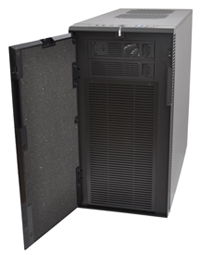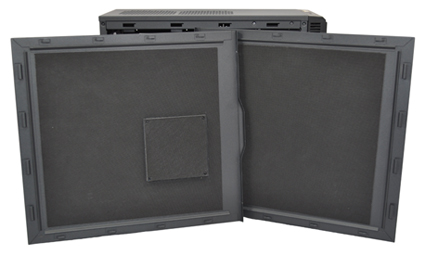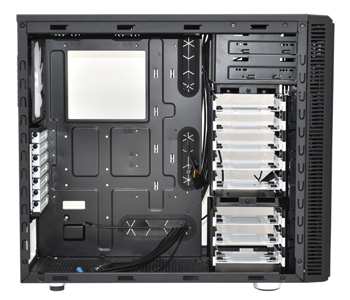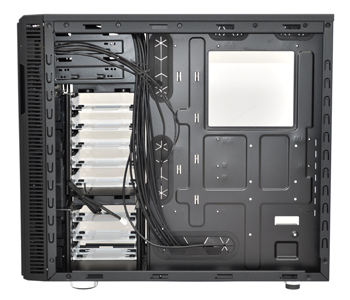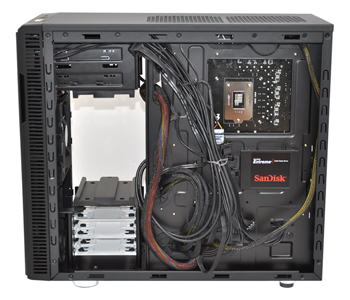Inside the Define R4
We're big fans of quiet enclosures, so it bodes well for Fractal Design that the Define R4 is built with "maximum sound reduction, configurability and functionality" in mind.
In keeping with the older R3, sound reduction is aided by dense bitumen material that lines the side panels and the inside of the front door. The door, incidentally, remains the same; it still opens to the left, it doesn't swing much beyond 90 degrees, a lack of rigidity in the hinges make it tricky to keep open, and the plastic materials don't provide a quality feel. A shame, really, as this is one area in which Fractal could quite easily improve the Define.
Behind the door, alongside the two 5.25in optical bays, is where the toggle switch for the integrated fan controller sits. Three fans can be connected and three operating modes are available; 12V (fast), 7V (medium) and 5V (slow). In keeping with the rest of the case, the fan controller provides excellent functionality but the toggle switch isn't particularly easy on the eye. We'd much prefer a dial as opposed to a small, inelegant plastic switch.
The Define R4 could be improved aesthetically, but Fractal seems to be paying more attention to functionality; and it shows. The front and bottom dust filters are large in size and easy to remove, and ModuVents are in place to give the user the ability to choose between quiet operation or maximum airflow.
These patent-pending vents are essentially 120/140mm fan mounts that are covered in thick, sound-absorbing material. The benefit, of course, is that users who want to increase airflow can add fans with ease - the Define R4 has seven fan mounts in total - and those who prefer a quiet system needn't worry about noise leaking from unused vents.
Just two fans are supplied as standard - a 140mm front intake and the 140mm rear exhaust - but the R4 has provision for another 120/140mm front intake, a bottom 120/140mm intake, a 140mm side fan and two 120/140mm top exhausts. The latter two vents can be used to mount a 240mm radiator, though we suspect radiator thickness would be limited to 30mm.
Crucially, the chassis feels good to build into. There's plenty of room for high-end components (CPU clearance is 170mm, GPU clearance is at least 295mm) and everything slots into place with no complications. The ease of use is aided by more small-but-significant changes. Instead of using small, rectangular cable-routing holes, the R4 is now equipped with larger, rounded cutouts that are easier to work with.
There's still a good-sized cutout in the motherboard tray, as well as rubber-grommeted holes for routing cables up-and-over the motherboard, but arguably the biggest improvement lies in the removable hard-disk cages. The right bays are now split into two sections with the top cage - holding five bays - pulling out after undoing a couple of thumb screws. The bottom three-bay cage can also be removed by undoing the screws on the underside of the chassis.
What's particularly useful is that the Define R4 provisions for two 2.5in SSDs to be mounted on the rear of the motherboard tray. If you're an SSD-only user, you could quite easily remove the entire 3.5in column and pave the way for unobstructed front-to-back airflow.
Filling out the Define R4 with our multi-GPU Ivy Bridge test platform proved to be a doddle, and the chassis' extra width does have its advantages; there's a decent amount of room behind the motherboard tray for excess cables, and routing the CPU power connector up and over the motherboard isn't as tricky as it used to be. You still need to be neat and tidy if you want to get the slot-in side panel to attach easily, but the 26mm clearance between tray and panel feels just about enough.
On the whole, there's very little wrong on the inside. Tool-free 5.25in bays would have been nice, and Vengeance C70-like cable-management clamps wouldn't go amiss, but it's ultimately satisfying to build into the Define R4 and it's easy to keep cable clutter hidden well out of view.
Editor's note: The PSU branding in the penultimate image on this page has been blurred as per Fractal Design's request.






